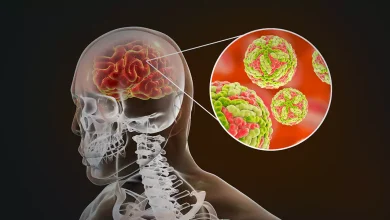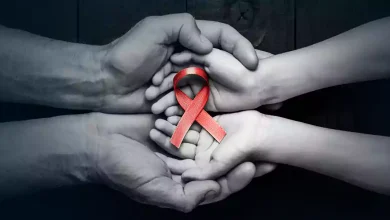All about Dry Skin
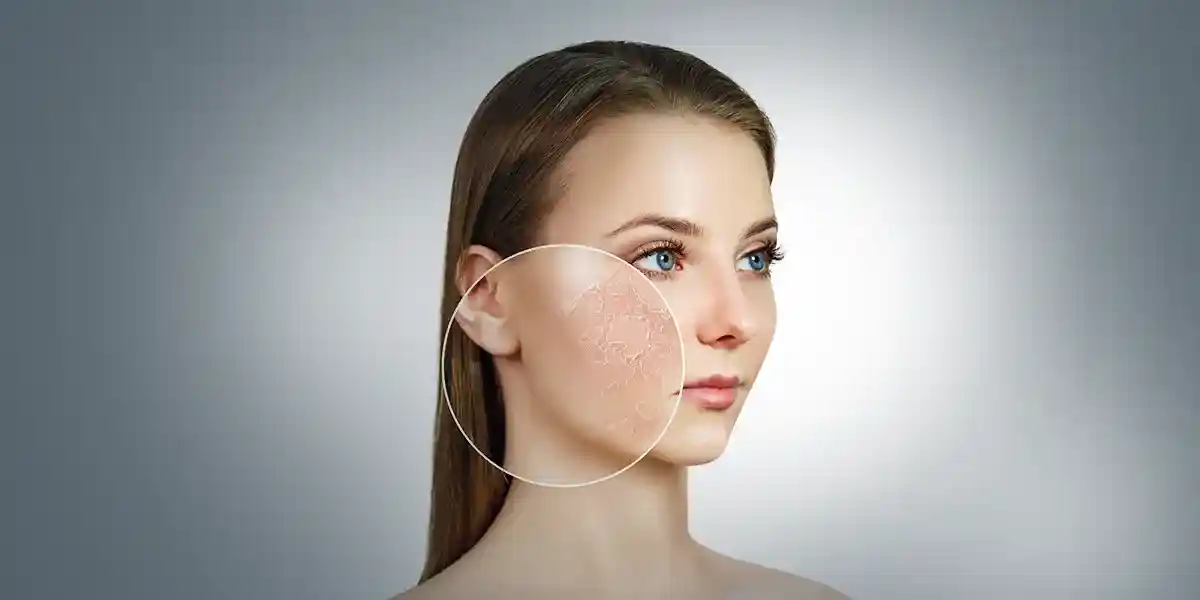
What is Dry Skin?
Dry skin causes a rough texture in your skin due to your skin not having enough moisture. Dry skin is quite common and the medical term for dry skin is called xeroderma. Dry skin can be treated at home by using moisturizers. Dry skin causes rough patches of your skin that can flake or seem scaly. If your skin is dry, it might or might not be itchy (pruritus). Dry skin if severe then may crack and bleed. If you have dry skin that doesn’t go away or keeps returning then you should talk to a dermatologist.
What are the Types of Dry Skin?
The types of dry skin include:
Contact dermatitis: Contact dermatitis happens when something comes into contact with your skin causing an irritant or allergic reaction. Your skin might be dry, red, and itchy, and a skin rash.
Eczema: Eczema is the term for a group of skin conditions that leads to dry, red, bumpy, and itchy patches of skin. If it gets severe then it can cause cracking of your skin, making it more prone to infection. This condition might worsen with irritants, allergens, and stress.
Seborrheic dermatitis: Dry skin on your scalp can occur because of dandruff in adults or cradle cap in infants. Seborrheic dermatitis might result in dry, flaky skin patches on your face, chest, and inside creases of your arms, groin, or legs. Rarely, your navel (belly button) can also be affected. This form of dermatitis happens when your body reacts to a normal yeast that grows on your skin.
Athlete’s foot: An athlete’s foot causes dry skin on your feet, caused by a fungus. When the fungus grows on your body, it’s known as “ringworm.” People with athlete’s foot suffer from dry, flaky skin on the soles of their feet.
What are the Symptoms of Dry Skin?
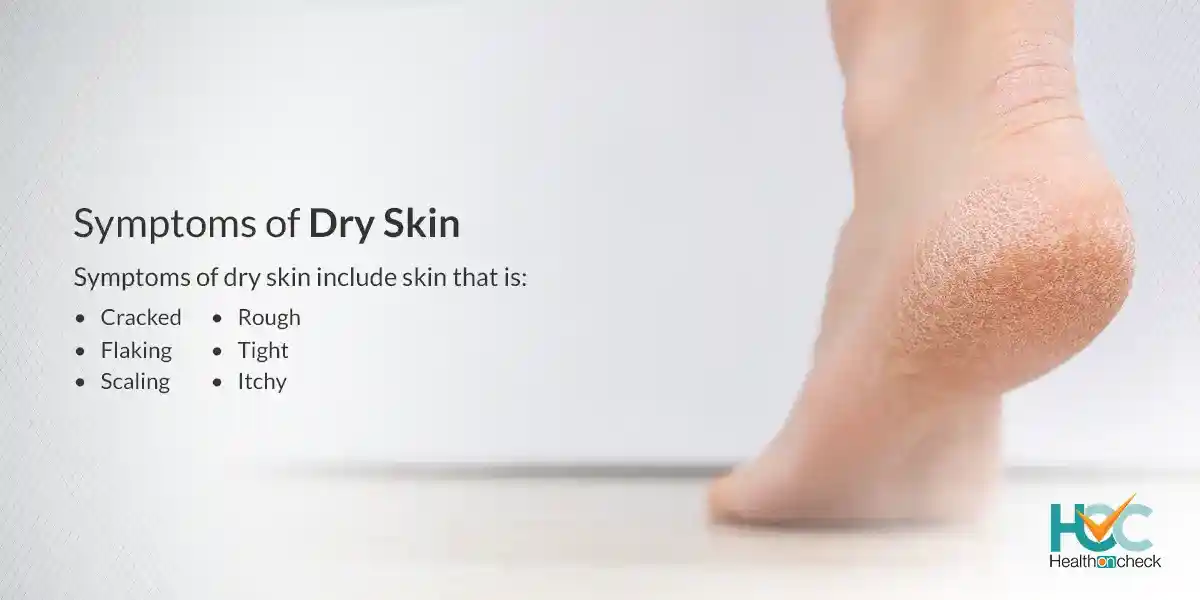
Symptoms of dry skin include skin that is:
- Cracked.
- Rough.
- Tight.
- Flaking.
- Scaling.
- Itchy.
- Lighter or darker than your normal skin tone or purple to red.
If you have severe dry skin, a rash might form on your skin.
What are the Causes of Dry Skin?
Dry skin occurs because of a lack of moisture within the layers of your skin. Causes of dry skin include:
Age: With passing age, the skin’s moisture-producing oil glands dry up which results in the fat and collagen (elasticity) in your skin drying up, causing thinning skin. It is a natural part of your body’s ageing procedure.
Climate: The temperature of your environment may impact your skin’s hydration. Climates lacking humidity such as desert-like climates or cold climates where there’s heavy wind may lead to dry skin. Dry skin usually gets worse during the winter, but dry skin can happen year-round.
Health conditions and genetics: Your chances of dry skin increase if you are born with genes making you more prone to it or if you have a health condition that results in dry skin as a symptom. Some conditions that cause dry skin include eczema, allergies, diabetes, and kidney disease.
Occupations: Some specific professions can cause dry skin, particularly if it involves working outdoors, with chemicals, or washing your hands regularly. Some professions that increase the risk of developing dry skin include healthcare providers, hair stylists, and farmers.
What are the Risk Factors of Dry Skin?
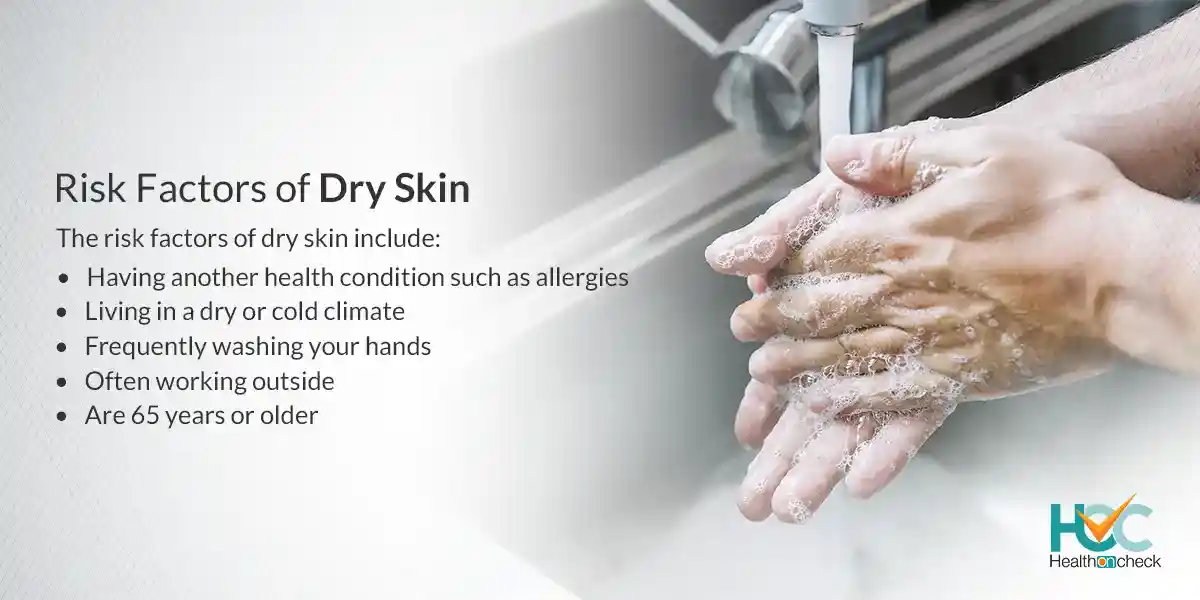
The risk factors of dry skin include:
- Living in a dry or cold climate.
- Often working outside.
- Frequently washing your hands.
- Having another health condition such as allergies.
- Are 65 years or older.
What are the Complications of Dry Skin?
Severe dry skin which lasts above six weeks may impact the quality of your life. It can disturb your sleep along with causing anxiety or depression. Prolonged dry skin can cause itching and scratching and possibly cause skin injury, scarring, and infection.
How Dry Skin is Diagnosed?
Dry skin can be easily diagnosed by its appearance. Your doctor will diagnose dry skin after checking your complete medical history, a physical exam, and getting more about your symptoms.
Based on the severity of your symptoms, your doctor might refer some tests to check for health conditions that might cause dry skin, including:
- Allergy test to determine factors or substances that cause allergic reactions.
- Blood tests to detect conditions such as diabetes or kidney disease.
- A skin biopsy or tissue sample to detect eczema or other skin disorders.
What are the Treatment Options Available for Dry Skin?
Treatment for dry skin mainly focuses on rehydrating or moisturising your skin. Treatment for dry skin may include:
Moisturisers: Moisturisers usually are the main form of treatment for almost all forms of dry skin. Moisturisers help to soften and smooth to avert cracking along with recreating your natural skin barrier. Moisturising products come in the forms of ointments, creams, lotions, and oils which include ingredients such as emollients, which soothe and hydrate your skin, and hyaluronic acid, which helps to increase moisture in your skin
Medications: For severely dry skin that’s itchy or prone to cracking, your doctor might precribe a topical steroid, which acts to reduce the swelling in your skin that causes a rash and itching. In some cases, oral or injectable medication is also prescribed.
Living with Dry Skin
Dry skin might seem rough and flaky which feels itchy and uncomfortable. Fortunately, dry skin does not cause any long-term problems. Although it’s usually a chronic condition, dry skin is very treatable. Discuss with your doctor about how to stop and soothe your dry skin. If other conditions, like eczema, are causing your dry skin, your doctor may prescribe medications and offer tips to treat the condition.
Whom to Consult?
You should consult with a dermatologist if your skin:
- Constantly itching constantly and interfering with your sleep or other daily chores.
- Seems infected.
- Pains when touched.
- A rash is developed.


